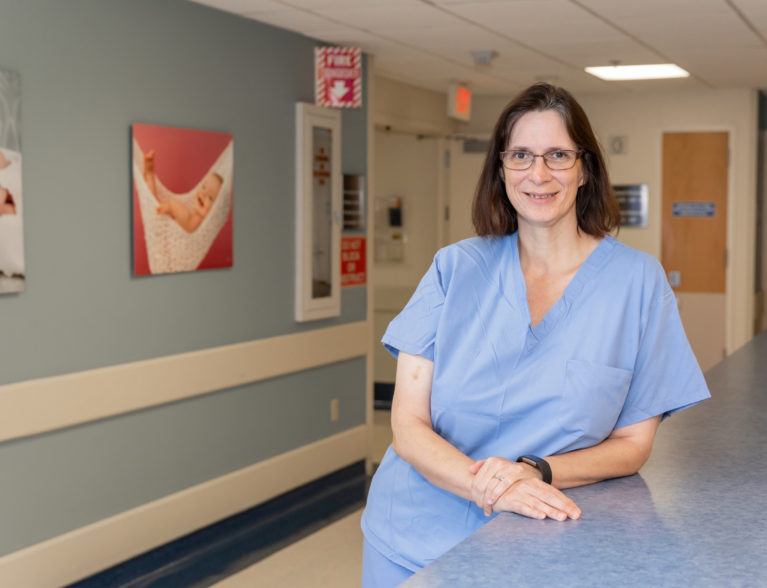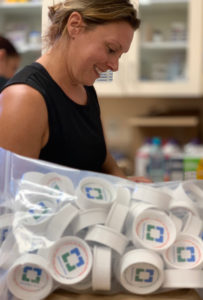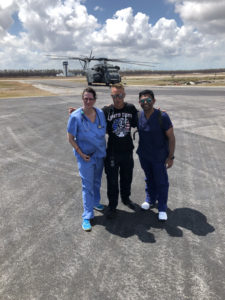
Mary Volsky’s usual work routine centers on the sparklingly clean and orderly labor and delivery rooms at Cleveland Clinic Indian River Hospital where she is the nurse manager.
On Sept. 9 that all changed. Radically.
 On that day, Volsky, two pilots and six other team members – Drs. Christine McKenna and Vailbav Wadhwa, pharmacist Marcie Ferraro, ER nurse Robyn Johns and a pair of paramedics drawn from throughout the Cleveland Clinic Florida Region – packed themselves, their supplies and their equipment into a small Cessna aircraft from Atheris Air, a medical transport company.
On that day, Volsky, two pilots and six other team members – Drs. Christine McKenna and Vailbav Wadhwa, pharmacist Marcie Ferraro, ER nurse Robyn Johns and a pair of paramedics drawn from throughout the Cleveland Clinic Florida Region – packed themselves, their supplies and their equipment into a small Cessna aircraft from Atheris Air, a medical transport company.
Taking off from Ft. Lauderdale, they headed to Marsh Harbour in the Bahama’s to deliver medical supplies and treat the injured in the aftermath of Hurricane Dorian.
The group was the second of two medical teams from Cleveland Clinic Florida Region that flew to the disaster scene.
“We had the plane packed with acute medical equipment,” Volsky says. “We had a defibrillator. We had all of that kind of equipment for emergencies. We also took a ton of medications. We were able to go to many of the outer islands and help in Abaco island setting up clinics.”
Volsky says the Cleveland Clinic team flew into Marsh Harbour and then “hopped by helicopter over to other islands. And our team didn’t stay constantly together. Some of us would go to one area and help, some of us would go to another area and help. So it was all around Abaco and Turtle Bay, Hope Town, Fox Town, Morris, Cooper Town and Marsh Harbour.
“We were also helping to facilitate medical transports and evacuation in general from the outer Islands and then help with setting up the clinics and dealing with any emergencies.”
All of that activity required close, coordinated communication and, almost astonishingly, despite the buzz-saw effects of Dorian’s Category 5 winds, which ripped down cell towers, power lines and telephone lines, Volsky’s team was able to stay in touch.
“We had radio communication in Hope Town, which is one of the islands,” Volsky says. “They had a really good system between all the people there with a little radio and their own little channel that they were using. Ourselves, we were able to text back and forth in some areas.”
And what did Volsky’s team find on its island-hopping missions?
 “There were quite a few puncture wounds and a lot of tetanus shots that were given,” Volsky says. In addition, many people had lost their medications for chronic diseases such as high blood pressure, diabetes and heart conditions, with medication damaged or pill bottles washed away in the storm.
“There were quite a few puncture wounds and a lot of tetanus shots that were given,” Volsky says. In addition, many people had lost their medications for chronic diseases such as high blood pressure, diabetes and heart conditions, with medication damaged or pill bottles washed away in the storm.
Fortunately Volsky’s team came prepared with, as she puts it, “a ton of insulin, tetanus vaccine, and medications for hypertension, diabetes and the like.”
This kind of volunteerism appears to come naturally to Volsky.
After some prodding she admits, “I always work the hurricanes here and I have since I started at [what was then] Indian River Memorial Hospital 25 years ago,” but it appears it’s rendering assistance, not publicity, that motivates her.
In fact, some unexpected publicity got Volsky’s husband in a little hot water last month when he proudly posted pieces about her Bahamas work on Facebook.
Volsky promptly asked him to take them down.
“It’s not about me,” she says though she admits she is more than happy to boast a bit about Cleveland Clinic.
“One of the pillars of Cleveland Clinic is community. And I appreciated the fact that Cleveland Clinic actually lived up to what they talked about, which is reaching out to a community in need,” Volsky says.
The work in the Bahamas, of course, is far from finished but with dozens of non-government organizations already onsite, the need for urgent medical attention has waned somewhat, even as the need to start rebuilding homes and other structures now comes into sharper focus.
Cleveland Clinic wasn’t the only medical organization helping out in the post-Dorian recovery efforts, but it is nice to know that Florida, which has seen its fair share of hurricane disasters, was able to offer so much to so many of our off-shore neighbors in their time of need.



